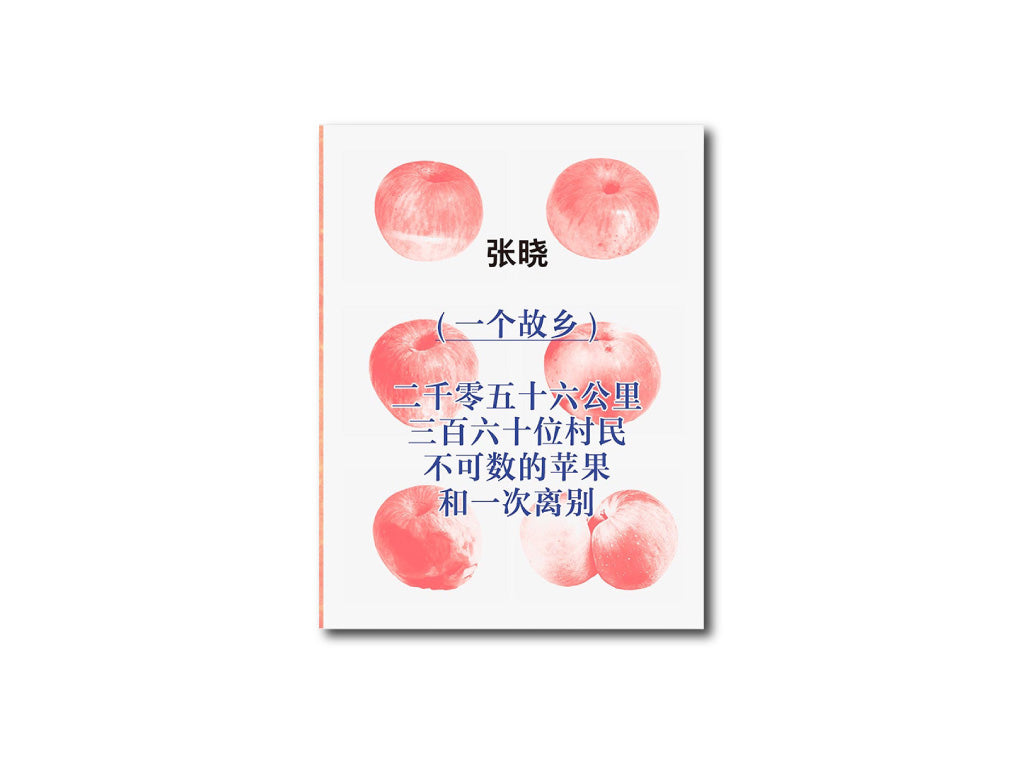
























135 x 180 mm |1112頁|ソフトカバー
*特装版あり
2011年以降、張暁(チャン・シャオ)はすべての作品を、自身の成長と記憶に密接に関連する、最もよく知る故郷にシフトしています。当初、彼はポラロイド乳剤のリフトを通して一連の作品を制作しました。自分自身と故郷を引き裂き、修復するプロセスのメタファーとして、またこれらのコラージュイメージを通して、記憶と現実の間のバランスを見出すためです。
そして、その時の張暁は、故郷に対して、むしろ村の中で放浪する子供のように、反射するコインの中に故郷の「廃墟」を目的もなく探しているようなものです。家の古い引き出しから古いものをすべて捨て、親戚の古い写真集をあさり、市場に隠れている写真館を歩き回り、さらには村人全員のポートレートを撮るために村議会の農村協同組合医療証を借りたりもした。
張暁は本作について、『中国の農村』の飛暁東の言葉を引用している。
「特定の生活集団にはそれぞれ特別な言語があり、他の言語では翻訳できない言葉や言い回しがたくさんある。これらの故郷のイメージは、地域社会の複雑な関係を、平坦な消費イデオロギーと美的論理に投影する、ある種の言語に過ぎない。」
張暁は故郷を調査する中で、幼い頃に自分を取り巻く農村の「美学」を徐々に構築し、あるいは再発見した。その様々な種類の視覚認識、方法、テキスト、色は、都市、ファッショナブル、モダンとは互換性があるが、しかしある程度、人々の都市への想像、権威、より良い生活への憧れを源としている 。
張暁にとって、故郷の散漫な探索の中で、「リンゴ」というシンボルは、他の作品よりも重要な意味を持っている。張暁の故郷に関する作品をすべて地図上に広げてみると、張暁のリンゴに関する作品は、あたかもそのような村の中心に果樹園を作るかのようであることがわかるだろう。と、彼は言う。
「 過去作「Them」や 「Coastline 」というマクロな視点から、故郷に戻り、そして今回のリンゴに至るまで、私の創作には「面」から「線」、「線」から「点」への過程がある。その後、故郷の地理的な「点」をなくし、より象徴的なもの−−リンゴに置き換えていきたいと考えています。」
1470枚の図版に、4つのエッセイとインタビューを収録した重量級の内容になっています。
---
About the Book
There is Special gift box edition limited in 100
A Hometown: 2056 kilometers, 360 villagers, countless apples & a farewell
Since 2011, Zhang has shifted all his work to the hometown he knows best, a place closely associated with his growth and memory. At the beginning, he created a series of works through polaroid emulsion lift, as a metaphor for the process of tearing and repairing himself and his hometown, and through these collage images, to find a balance between memory and reality.
And the Zhang Xiao at that time, to the hometown, is more like a wandering kid in the village, aimlessly looking for the hometown "ruins" in the reflective coins. He dumped all the old stuff out of the old drawers of his house, rummaged through his relatives' old photo albums, roamed the photo studios hidden in the market, and even borrowed the village council's rural cooperative medical certificate for everyone in the village in order to get a portrait of all villagers.
In his work on hometown, Zhang Xiao quotes Fei Xiaotong in his work Rural China : "Every specific living group has its special language, and there are many words and phrases that cannot be translated in other languages. These images of hometown are just some language that projects the complex relations in the local society into the flat consumption ideology and aesthetic logic."
During the research of his hometown, Zhang Xiao gradually built up, or rediscovered the rural "aesthetics" surrounding him at his early ages, that various kinds of visual perception, schema, text, color which is in compatible to the urban, fashionable, modern, however, to some extent, sources from people's imagination to the city, the authority and yearning of a better life .
In his scattered exploration of his hometown, the symbol "Apple" is of more significance to Zhang Xiao than other works. If all of Zhang Xiao's works about his hometown are spread out on a map, we will find that Zhang Xiao's works about apples, as if in the center of such a village, build an orchard. He said: "From the macro perspective of 'Them' and 'Coastline', to the return to my hometown, and then to Apple, my creation has a process from 'surface' to 'line', from 'line' to 'point'. After that, I hope to eliminate the geographical "dot" in my hometown and replace it with something more symbolic -- an apple."
